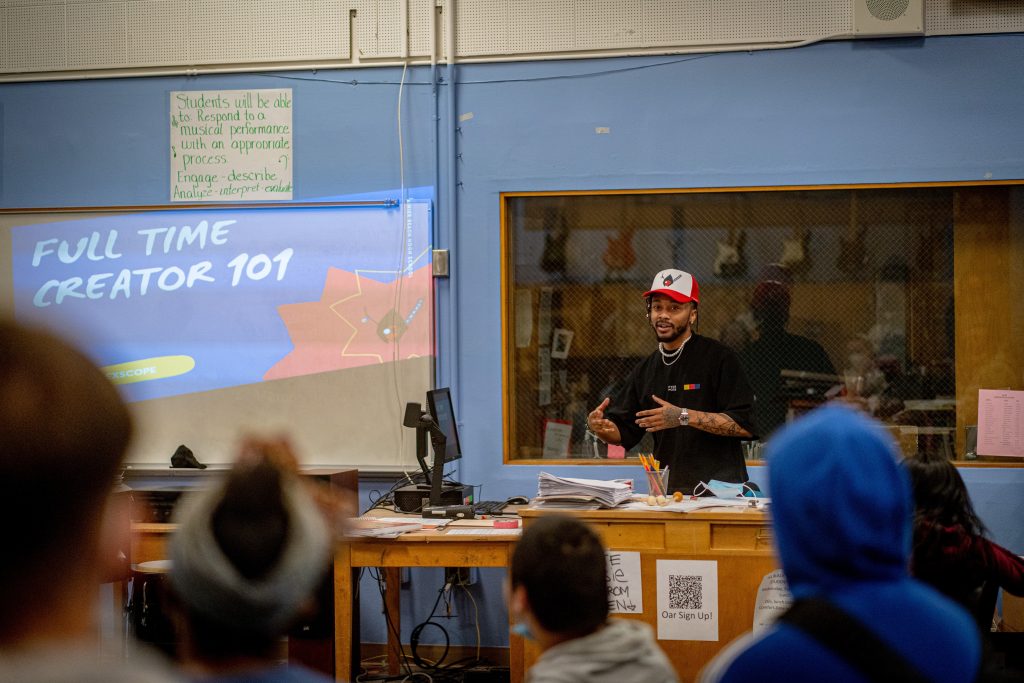By Carolyn Jones for CalMatters
Five years ago, California embarked on an ambitious plan to bring computer science to all K-12 students, bolstering the state economy and opening doors to promising careers — especially for low-income students and students of color.
But a lack of qualified teachers has stalled these efforts, and left California — a global hub for the technological industry — ranked near the bottom of states nationally in the percentage of high schools offering computer science classes.
“I truly believe that California’s future is dependent on preparing students for the tech-driven global economy. You see where the world is going, and it’s urgent that we make this happen,” said Allison Scott, chief executive officer of the Kapor Foundation, an Oakland-based organization that advocates for equity in the technology sector.
Scott was among those at a conference in Oakland this week aimed at expanding computer science education nationally. While some states — such as Arkansas, Maryland and South Carolina — are well on their way to offering computer science to all students, California lags far behind. According to a 2022 report by Code.org, only 40% of California high schools offer computer science classes, well below the national average of 53%.
California’s low-income students, rural students and students of color were significantly less likely to have access to computer science classes, putting them at a disadvantage in the job market, according to a 2021 report by the Kapor Center and Computer Science for California.
Slow signs of progress

The state has made some progress in the past few years, since adopting its sweeping Computer Science Strategic Implementation Plan and curriculum standards in 2018. More students are taking and passing the Advanced Placement computer science exams, and schools are gradually adding computer science curriculum either as a stand-alone class or integrated into math, science or other courses. The University of California now accepts computer science as satisfying a third or fourth year of math or science, instead of just as an elective. And some districts, such as Oakland Unified and San Francisco Unified, have greatly expanded their computer science offerings, thanks in part to a grant from the Salesforce Foundation.
To help solve the computer science teacher shortage, Gov. Gavin Newsom this month signed Assembly Bill 1251, which creates a commission that will look at ways to streamline the process to become a computer science teacher. The current process is so arduous, some say, it’s keeping high-quality teachers from the classroom, especially in rural and low-income areas.
Currently, there are three ways to teach computer science in California. One is to earn a career and technical education credential, which requires work experience but no post-graduate coursework. Another is to hold a math, business or industrial technology credential. The third is to obtain a credential in any subject and then add an extra 20 units of computer science. Because of confusion over requirements, funding and curriculum, schools have a hard time finding the right teachers to teach specific classes.
“The goal is to ensure we have well-prepared computer science teachers for all students, so they can engage in the world around them. We’re making progress, but we have a ways to go,” said Julie Flapan, director of the Computer Science Equity Project at UCLA. The new law should help eliminate that confusion, possibly leading to the creation of a computer science credential.
Due in part to the lack of teachers, a bill that would have required all California high schools to offer computer science stalled in the Senate this year. It’s also a reason California is among the states that doesn’t require computer science to graduate, although State Superintendent of Public Instruction Tony Thurmond said Wednesday that he might propose such legislation next year.
A lack of teachers isn’t the only roadblock to expanding computer science. School administrators and counselors also must prioritize the subject, Flapan said, making sure it’s offered and that students in underrepresented groups understand the benefits and have access to classes.
Computer science has evolved to include more than basic coding. A good class now includes lessons on artificial intelligence, media literacy, data science, ethics and biased algorithms, so “students know how to think critically to solve problems using technology,” Flapan said.
Easier paths to teach computer science

Becoming a computer science teacher can be a long and expensive process, but San Francisco State University has found a way to make the pathway more enticing. Using grant money from the National Science Foundation, the university is offering online courses for teachers who want to gain the extra 20 units in computer science, enabling them to teach at the high school level.
Since it launched the program in 2018, San Francisco State has trained more than 150 computer science teachers and is helping other universities start similar programs. Every year it’s flooded with applications from throughout California, said Hao Yue, assistant chair of the computer science department at San Francisco State and a leader of the computer science education program.
Some of the participants are current teachers who want to broaden their qualifications, in some cases for a bump in pay, while others are referred by their districts. The university is trying to broaden the pool further by luring undergraduates.
“When you’re majoring in computer science, all you hear about is becoming a software engineer. They don’t know that teaching is an option. But some of them love working with kids, love teaching, and we’re able to help them become teachers,” Yue said.
Two years ago, Newsom allotted $15 million in the state budget to help teachers of other subjects obtain their 20 extra units of computer science. The state Department of Education has also made $20 million available to train teachers, counselors and administrators in computer science.
UC Berkeley also runs a free program to help teachers qualify to teach computer science. Funded in part through a grant from Google, the program gives teachers the credits they need to teach computer science, as well as guidance on how to make computer science more accessible to students of color, students with disabilities and low-income students.


Be the first to comment on "A shortage of teachers for computer science classes puts California near the bottom of a national instruction ranking"